The largest and deepest ocean in the world, the Pacific extends from the Arctic Ocean in the north to Antarctica in the south. It covers 46% of the earth’s water surface and is larger than any landmass on earth.
The vast body of water is home to some of the most unusual life forms on earth. These unique animals are part of the sea’s amazing ecological diversity.
Because of its size and reach, there are dozens of countries that have coastlines on the Pacific. Among them are Australia, Chile, Fiji, Mexico, Peru, Thailand, the United States, and Vietnam.
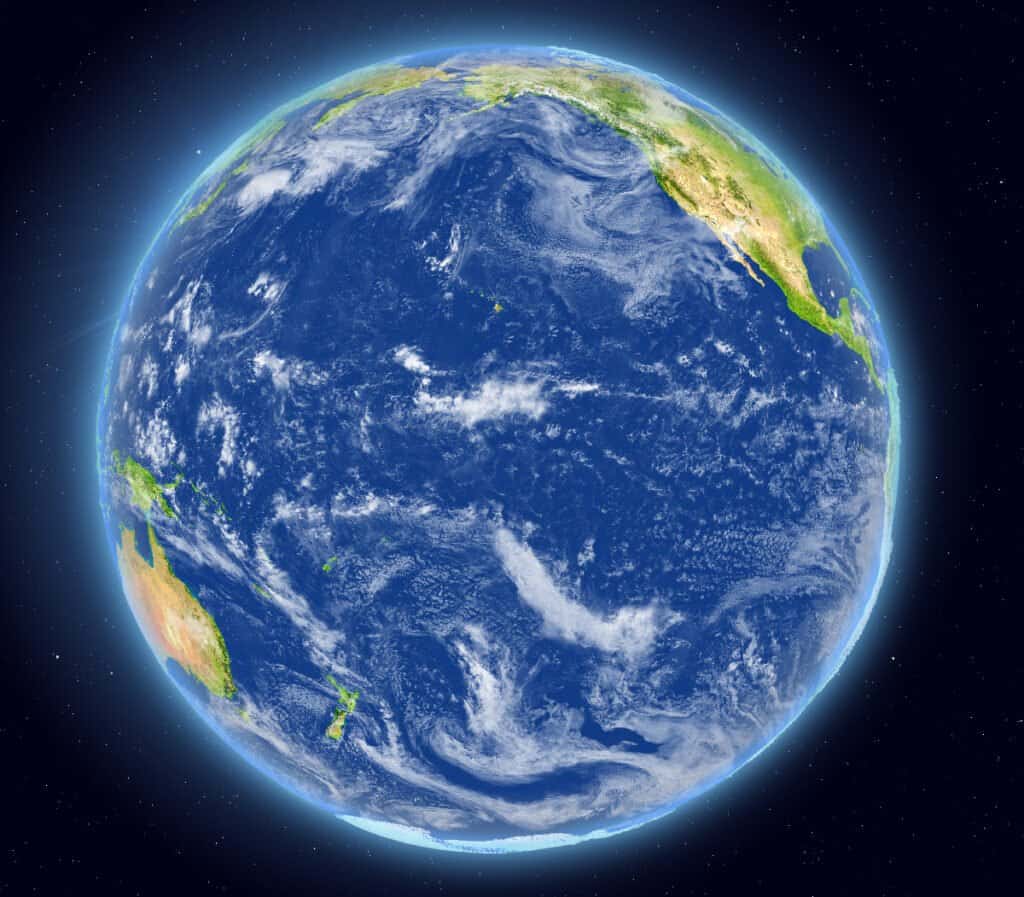
The Pacific Ocean is the largest and deepest body of water on Earth.
©Harvepino/Shutterstock.com
The main seas of the Pacific are:
- Coral Sea.
- South China Sea.
- East China Sea.
- Bering Sea.
- Solomon Sea.
- Sea of Japan.
- Bali Sea.
- Gulf of California.
- Gulf of Tonkin.
The Pacific Ocean provides a rich feeding ground for many types of wildlife.

A dugong was the only completely marine mammal that had a diet consisting solely of seagrass.
©Laura Dts/Shutterstock.com
Important ecosystems of the Pacific include seagrass meadows, which are important breeding and feeding grounds for manatees and dugongs. Coral reefs are vital parts of the food chain. They support thousands of marine species, including reef fish, sharks, and sea turtles.

Sea turtles live among seagrasses in the Pacific Ocean.
©Isabelle Kuehn/Shutterstock.com
The coastlines of the Pacific Ocean have their own wildlife. In the northern regions, you will find many penguin species, including Galapagos penguins and rockhopper penguins.
Seabirds of the Pacific include gulls, pelicans, cormorants, grebes, loons and terns. Some unique species are the Leach’s storm petrel, the least tern and the Pacific loon.
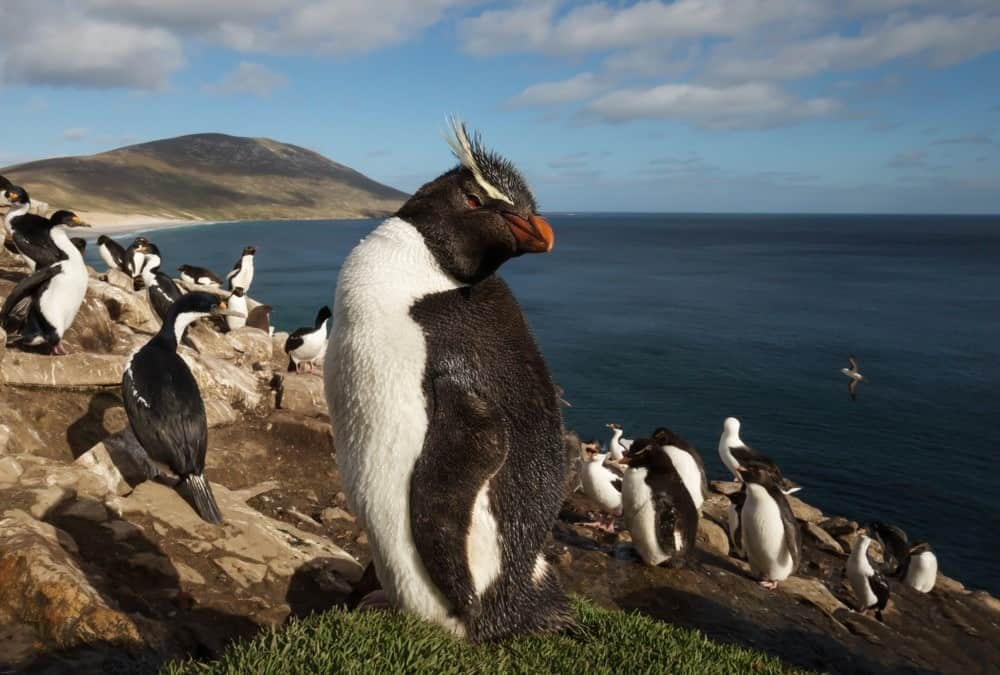
Rockhopper penguins and Imperial Cormorants can be seen on the Falkland Islands, Pacific Ocean.
©Giedriius/Shutterstock.com
The Official National Animal of the Pacific Ocean
The Pacific Ocean does not have its own national animal. Many countries border the Pacific. Here are the national animals of some of these countries.
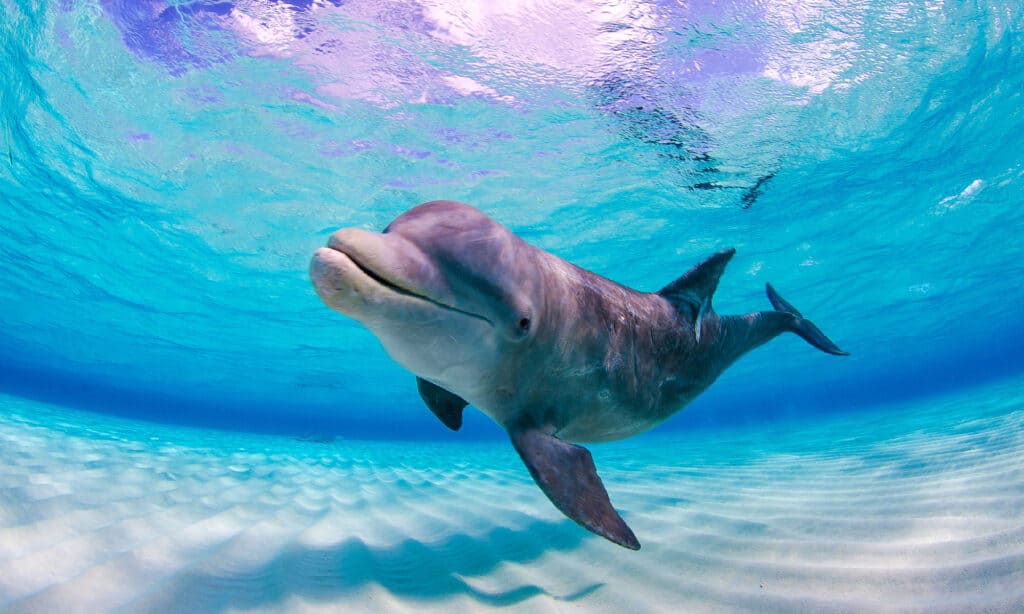
The dolphin is the national animal of Vanuatu, a country that borders the Pacific.
©iStock.com/Michelle de Villiers
Where To Find the Top Wild Animals in the Pacific Ocean
The coral reefs of the Pacific are some of the best places to see fish and marine mammals. Snorkeling and scuba diving are popular tourist activities in many islands and coastal areas on the Pacific.

Blue tang helps keep coral reefs from suffocating.
©Charlotte Bleijenberg/Shutterstock.com
The Great Barrier Reef, located in the Pacific off the coast of Australia is the longest and largest reef complex in the world. It is the largest living thing on Earth and can be seen from space – made up of 600 types of hard and soft coral. The second-largest, the Belize Barrier Reef, off the Pacific coast of Central America, offers opportunities to see many endangered species including sea turtles, manatees and the American marine crocodile.
Whales migrate from feeding grounds in the Bering Sea to south to equatorial waters for mating every year. Gray whales, humpbacks, dolphins, blue whales and orcas make the trip – and are easy to see on guided whale watching tours in California, United States, and many other destinations along the Pacific.
Whale watching, dolphin tours and birding are great opportunities to spot wildlife and waterfowl. Many countries that border the Pacific have conservation areas where you can see this unique local wildlife.
The Most Dangerous Animals in the Pacific Ocean
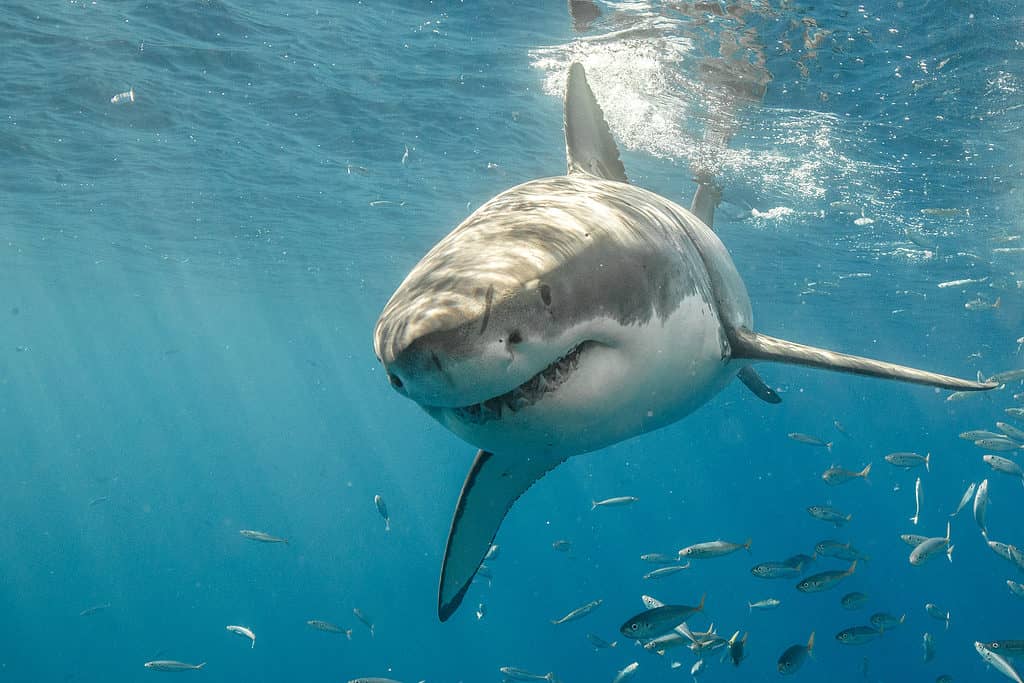
Great white sharks are the ocean’s apex predators.
©iStock.com/ShaneMyersPhoto
Sharks
The Pacific is home to many dangerous, aggressive sharks. The great white is one of the largest and deadliest predators in the ocean. They cause one-third of all shark attacks on humans.
Tiger sharks are almost as dangerous. They hunt close to the shore and will eat anything. They are responsible for several attacks on humans every year.

Banded sea kraits are venomous snakes that prey on eels that live on coral reefs.
©Richard Whitcombe/Shutterstock.com
Sea Snakes
The Pacific Ocean’s sea snakes are some of the most venomous snakes in the world. Also known as coral reef snakes, they are long, colorful snakes who spend most of their lives in the water. Their bites are often painless, but they can be fatal.
Sea snakes only live in the Pacific and Indian oceans. There are no sea snakes in the Atlantic, Caribbean Sea or Red Sea.

The most venomous
box jellyfish
are in the Pacific and Indian Oceans.
©Nuttawut Uttamaharad/Shutterstock.com
Jellyfish
The Pacific Ocean is home to many dangerous jellyfish. They include the sea nettle, which have a bell-like shape and can reach 3 feet. Its tentacles can be 15 feet long. The sea nettle’s sting is very painful to humans.
The box jellyfish causes more deaths than any other. The most venomous ones are in the Pacific and Indian Oceans.
Largest Animal in the Pacific Ocean

The blue whale is the largest animal in the Pacific Ocean, and the largest animal ever to have lived on earth.
©Andrew Sutton/Shutterstock.com
The largest animal on earth is also the largest in the Pacific Ocean. The blue whale can grow up to 100 feet long and weigh upwards of 200 tons! A blue whale’s tongue weighs as much as an elephant and its heart weighs as heavy as an automobile. It’s hard to believe an animal can grow so huge on a diet of tiny krill – but apparently eating four tons a day does the job!
The largest numbers of blue whales are in the eastern North Pacific but they are currently threatened by collisions with ships, entanglement in fishing nets and reduction of zooplankton due to habitat reduction and disturbance from low frequency noise.
This endangered baleen whale has a long and slender body of various shades of gray-blue. This whale is often solitary except for mother-calf pairs but have been seen in gatherings of up to 50 individuals. Blue whales migrate to their summer feeding grounds toward the poles but gather near equatorial waters to breed in the winter. The animals seem to use their memory to know where and when to migrate. Not only are blue whales the largest animal on the planet – they are the largest animal ever to have existed.
Rarest Animal in the Pacific Ocean
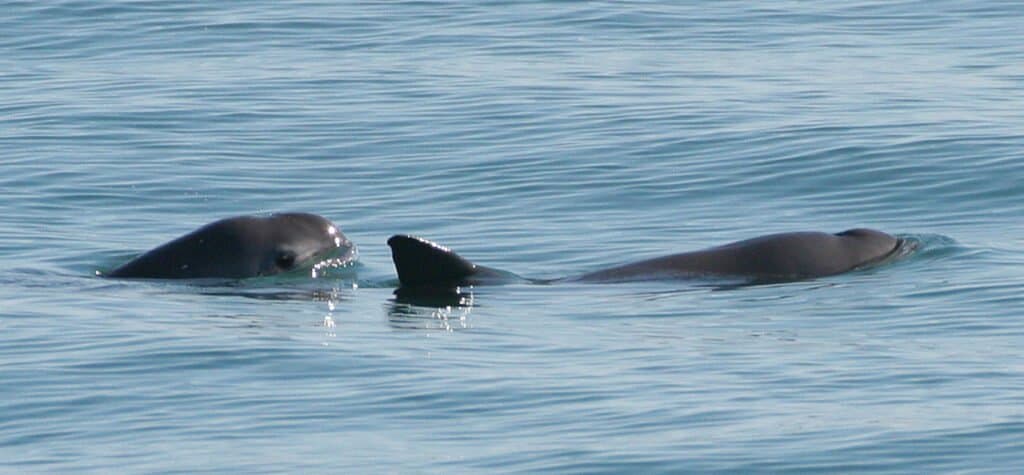
On the brink of extinction, the vaquita is the smallest living species of cetacean and the rarest animal in the Pacific.
©Paula Olson, NOAA, Public domain, via Wikimedia Commons – License
Discovered for the first time in 1958, the vaquita is a little porpoise native to Mexico’s Gulf of California. Vaquita are often caught and drowned in fishing nets used in illegal fishing operations. There are only ten vaquita left today.
Vaquita are the smallest living species of cetacean at five feet long and 120 pounds. They have dark patches on their lips that form a thin line from lips to pectoral fin and a large dark ring around their eyes. Its top is dark gray with lighter gray on the sides and a white underbelly with long gray markings. They are most often seen in shallow waters close to shore.
Endangered Animals in the Pacific Ocean

Hawaiian monk seals are almost extinct.
©iStock.com/leightrail
Just like animals on land, sea creatures face worsening threats to their survival. The Pacific ocean, at first glance, seems to be teeming with infinite life, but upon closer inspection, much of the wildlife is in danger. All forms of marine species are at risk, including cetaceans, seabirds, sea turtles, sharks and other fish and invertebrates.
It’s difficult to measure the full extent and causes of marine extinction because the ocean itself is so vast – but there are some obvious culprits. Entanglement in nets and lines, hunting and capture by humans, collisions with ships, pollution and habitat degradation and climate change are some of the causes of marine life decline. Some of the animals in danger are:
- Bull shark (Carcharhinus leucas): This large, aggressive shark lives in the warmer regions of the Pacific.
- Sea otter: Sea otters almost became extinct. Hunting bans and conservation programs have helped their populations recover, but they are still endangered.
- Branch coral (Acropora florida): Branch coral is critical to healthy ocean ecosystems. Climate change and extreme weather events have caused its population to decline.
- Vaquita (Phoeocna sinus): This tiny porpoise is the smallest and most rare cetacean in the world. Vaquitas are unique to the Gulf of California. Vaquitas, whose name means “little cow,” are on the brink of becoming extinct. They are frequently killed by gillnets used in illegal fishing.
- Dugong (Dugong dugon): The sea cow is a large, gentle creature like a manatee. It lives in warm waters that are rich in seagrass, which it uses for food. Dugongs are protected, but some people hunt them for their skin, meat and bones.
- Whale shark (Rhincodon typus): The largest fish in the world, this giant can reach 40 feet or longer. Although they are huge, these sharks are harmless to humans. They feed on plankton and small fish.
- Hawaiian monk seal (Neomonachus schauinslandi): This seal is endemic to the Pacific coast of Hawaii. The monk seal is almost extinct.
A Vast Ocean of Wildlife

The Orca are the largest of the dolphins and are at the top of the Pacific ocean food chain.
©Andrea Izzotti/Shutterstock.com
The Pacific Ocean is home to millions of unique creatures. From killer whales at the top of the food chain to sea slugs at the bottom, it is a vast ecosystem. Scientists have not finished identifying all the wildlife that lives in this deep ocean.
Consider that the little vaquita was discovered only 65 years ago and now there are only ten left. There are no doubt more animals like the vaquita out there waiting to be realized and celebrated. Let’s hope to see more new wonders and to see diminishing species rebound. To quote the great oceanographer, Jacques Cousteau, “The sea, the great unifier, is man’s only hope. Now, as never before, the old phrase has a literal meaning: we are all in the same boat.”
Pacific Ocean FAQs (Frequently Asked Questions)
What Kind of Animals Live in the Pacific Ocean?
- Birds: Penguins, puffins, albatrosses, terns, curlews, pelicans, herons and egrets.
- Marine mammals: Sea otters, manatees and dugongs.
- Fish: Salmon, cod, halibut, marlin, tuna, ladyfish, herring and sardines.
- Pinnipeds: Seals, fur seals, walruses and sea lions.
- Cetaceans: Whales, dolphins and porpoises.
- Mollusks: Clams, oysters and mussels.
- Shellfish: Shrimp, lobster, crabs and crayfish.
How Many Species Live in the Pacific Ocean?
There are currently 228,450 known species in the ocean. The exact number is unknown because scientists say more than 90% of ocean life remains unknown and unexplored. In 2020, biologists identified 1,500 new species. They estimate there may still be between 500,00 and 2 million more that have not been identified.
What Is the Most Dangerous Animal in the Pacific Ocean?
The most dangerous animal is the killer whale.
Killer whales, also known as orcas, are massive, aggressive killers who are at the top of the ocean food chain. They live in every region of the Pacific and every ocean and sea except the Arctic.
At over 25 feet long with rows of powerful teeth, the orca preys on large fish, dolphins, sharks, and whales. The largest killer whale population is in the northern Pacific near the Aleutian Islands.
Thank you for reading! Have some feedback for us? Contact the AZ Animals editorial team.



